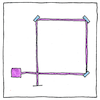Max von Laue,
Georges Sagnac
physics

|
Sagnac effect
In 1913, Georges Sagnac split a beam of light and sent each half in opposite directions around a ring. When he rotated the ring he observed an interference pattern in the recombined beams and concluded the aether is stationary relative to earth. Max von Laue had predicted the interference in 1911, but explained it is because light travels at a fixed speed no matter how fast the source of the light travels (according to Einstein’s theory of special relativity), and because when the ring is rotated, although the two beams travel along the same path, this path is lengthened in the direction of rotation and shortened in the opposite direction.
Experiments
Sagnac’s experiments in 1913 continued the work by Michelson and Morley in 1887 that compared the speed of light in perpendicular paths in order to detect stationary aether. The idea was that since light propagates as a wave, something that we can’t see or feel must be waving, and they called this medium “luminiferous aether.” Stationary aether is aether that moves with earth in its orbit. Michelson and Morley didn’t detect stationary aether, so Sagnac tried to find evidence of aether moving relative to the earth, and didn’t find it, so he thought he had proved the aether was stationary. Meanwhile Franz Harress tried to measure the Fresnel drag of light through rotating glass in 1914 and found the same effect as Sagnac, but couldn’t explain it, describing it as an systematic bias in his measurements. The effect of the glass was supposed to be the same as the effect of any medium such as water or aether. The speed of light was supposed to be increased by the glass moving it its direction, and impeded by the glass moving against it. In the Sagnac and Harress experiments, the opposite occurred; it took longer to traverse the path for the beam moving in the direction of rotation and shorter for the beam moving in the opposite direction. Von Laue came back in 1920 to explain the Sagnac effect in Harress’s experiment. The fact that the speed of light is reduced when propagating through glass had nothing to do with the fact the glass was moving, and nothing to do with the interference pattern.
Interferometry
Hologram Laser gyroscope Laser Interferometer Gravitational-Wave Observatory We have widely applied this trick for detecting small differences, extremely small differences. We could hear the breathing and sighing of a mite that crawls upon the chin hair of a flea. We can hear you murmur in your sleep from the vibrations of the window in your room. If that’s not a fine enough interference, wait until we can tell what you are dreaming.



Albert Einstein refuted Michelson, Morley, Sagnac, and Harress; the theory of special relativity made the search for luminiferous aether unnecessary.
See also in The book of science:
Readings in wikipedia: